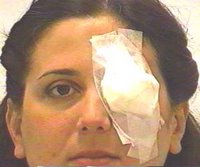This study concludes:
"Elevated IOP may increase the risk of nuclear cataract, but not that of other
types. The use of glaucoma medications could magnify this risk."
"Elevated IOP may increase the risk of nuclear cataract, but not that of other
types. The use of glaucoma medications could magnify this risk."
"Previous reports have proposed that cataract surgery during the first 5 to 8
weeks of life is associated with better visual outcomes in children with dense
bilateral congenital cataracts. Our results would suggest that good visual
outcomes can be achieved beyond this age, but the incidence of poor visual
outcomes increases if cataract surgery is delayed beyond 10 weeks of age. The
absence of preoperative nystagmus is a better predictor of a good visual outcome
than the age at surgery."
"Daily-wear opaque contact lens treatment is a useful occlusion method for
amblyopia treatment in older children with various practical and social
impediments to skin patching. Meaningful improvement in visual acuity can be
obtained, even in children older than 8 years of age."


"A perception of dryness may be caused by non-dry conditions of which four are presented here: (1) lid margin touch, (2) conjunctival laxity, (3) cilia touch, and (4) fibrin accumulation in conjunctival inflammation".Under lid margin touch I've seen inspissated meibomian glands where the hardened dome/s were probably the cause. Another cause may be anterior basement membrane dystropy.
"Inferior region RNFL thickness was significantly decreased in the attacked eyes after an APAC episode associated with normal visual field."
"The present study documents the potential efficacy of topical dorzolamide for treating CME in patients with RP. We observed that some patients may show a “rebound phenomenon” with continued use of the medication; hence, there is a need for careful follow-up in patients being treated."
"there is no evidence of product contamination, tampering, counterfeiting or sterility failure. That leads us to conclude that some aspect of the MoistureLoc formula may be increasing the relative risk of Fusarium infection in unusual circumstances."Another troubling note is that there were three cases of patients developing fusarium keratitis who used Alcon's Optifree ReFResh.
"The effects of systemic administration of simvastatin on the retinal circulation after 90 minutes and after 7 days were studied in a placebo-controlled, double-masked, clinical trial among 12 healthy men.
"There were no significant changes in any retinal circulatory parameters at 90 minutes after administration of simvastatin. Daily administration of simvastatin for 7 days significantly increased blood velocity and blood flow in retinal arteries and veins but did not significantly change vessel diameter. The intraocular pressure significantly decreased at 90 minutes and at 7 days after administration of simvastatin.
Conclusion: Simvastatin induced an increase in blood velocity and blood flow in retinal arteries and veins, and decreased the intraocular pressure, probably through the increase in nitric oxide."

"Treating simple corneal abrasions with a patch does not improve healing rates on the first day post-injury and does not reduce pain. In addition, use of patches results in a loss of binocular vision. Therefore it is recommended that patches should not be used for simple corneal abrasions. Further research should focus on large (greater than 10 mm2) abrasions."
"In the study period with the current equipment, our results showed that conventional LASIK retreatment was superior to wavefront-guided LASIK retreatment in both efficacy and safety."
- Topamax, a medication used for epilepsy, migraine, and weight loss can induce bilateral angle closure glaucoma.
- Don't forget glaucomacyclitic crisis (check for cells).
- Consider gonio in fellow eye if it's contraindicated in involved eye.
- Don't forget pilo 2% if IOP is < 40mmHg.
- Don't allow patient to leave office if IOP is more than 30mmHg.
-Higher prevalence in females with Scandinavian descent.
-2/3 develop bilateral ocular disease.
"Only seven percent said they perform checks at the start of each clinical session, and eight percent check the tonometer for calibration errors if they had suspicious or unexpected measurements."The summary in Optometric Physician concludes:
"Tonometers should be checked for calibration errors at least monthly."
"In the patients treated with NGF, on day 21, we found with OCT a complete wound healing, and the stromal incision was not visible. Conclusions: This clinical experience shows that the topical administration of NGF is effective in accelerating the healing of surgical corneal wounds."


"FDT perimetry appeared more sensitive than standard automated perimetry in detecting early glaucomatous fisual field loss. The FDT-N-30 test showed a slightly higher ability to detect early glaucomatous damage in patients at risk for the development of glaucoma, whereas the 30-2 test provided a more detailed characterization of the glaucomatous VF loss pattern, although it required 30% more time."